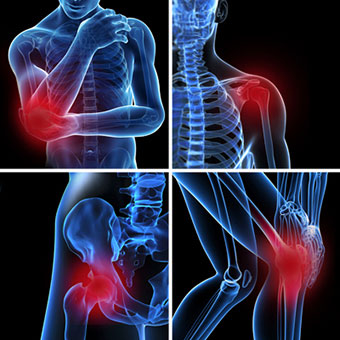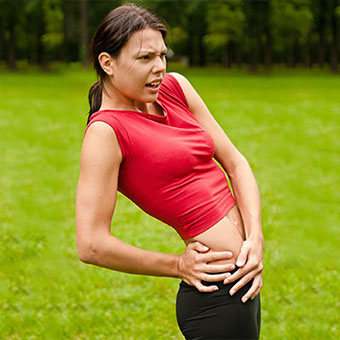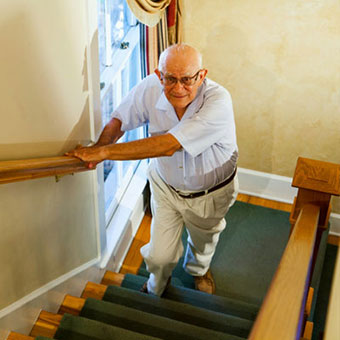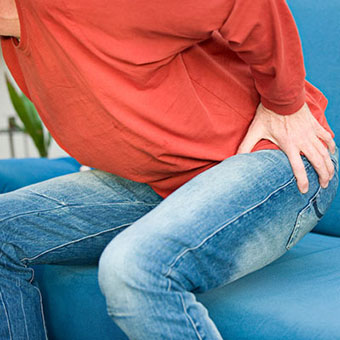Hip Bursitis
- Facts
- Pain
- What Is It?
- Causes
- Risk Factors
- Symptoms
- Diagnosis
- Doctor Specialists
- Treatment
- Physical Therapy
Hip bursitis facts
- A bursa is a fluid-filled sac that functions as a gliding surface to reduce friction between moving tissues of the body.
- There are two major bursae of the hip.
- Bursitis, or inflammation of a bursa, is usually not infectious, but the bursa can become infected.
- Treatment of noninfectious bursitis includes rest, ice, and medications for inflammation and pain. Infectious bursitis (uncommon) is treated with antibiotics, aspiration, and surgery.
- Bursitis of the hip is the most common cause of hip pain.
- Trochanteric bursitis frequently causes tenderness of the outer hip.
- Ischial bursitis can cause dull pain in the upper buttock area.

What is bursitis?
A bursa is a closed fluid-filled sac that functions as a gliding surface to reduce friction between tissues of the body. "Bursae" is the plural form of "bursa." The major bursae are located adjacent to the tendons near the large joints, such as the shoulders, elbows, hips, and knees. When a bursa becomes inflamed, the condition is known as "bursitis."

What is hip bursitis?
There are two major bursae of the hip, the trochanteric bursa and the ischial bursa. These are located adjacent to the edges of the femur (thighbone) and pelvic bone, respectively. Inflammation of either can be associated with stiffness and pain around the hip joint. The trochanteric bursa is located on the side of the hip. It is separated significantly from the actual hip joint by tissue and bone. Bursitis is not arthritis and, therefore, is not a cause of true joint pain.

What causes hip bursitis?
Most commonly, bursitis is a noninfectious condition (aseptic bursitis) caused by inflammation that results from local soft-tissue trauma or strain injury. On rare occasions, the hip bursa can become infected with bacteria. This condition is called septic bursitis. Although uncommon, the hip bursa can become inflamed by crystals that deposit there from gout or pseudogout, or from calcinosis as a result of scleroderma.
What are risk factors for hip bursitis?
Risk factors for hip bursitis include activities that could strain the hip area, including going up and down stairs, repetitive activities such as stair-climber exercising, etc.

What are hip bursitis symptoms and signs?
Bursitis of the hip is the most common cause of hip pain.
Trochanteric bursitis
Trochanteric bursitis frequently causes pain and tenderness of the outer hip and thigh, making it difficult for those affected to lie on the involved side, frequently causing difficult sleep. Trochanteric bursitis also causes a dull, burning pain on the outer hip and thigh that is often made worse with excessive walking, exercise, or stair climbing. Iliotibial band syndrome can sometimes mimic or be associated with trochanteric bursitis.
Ischial bursitis
The ischial bursa is located in the upper buttock area. Ischial bursitis can cause dull pain in this area that is most noticeable when climbing uphill. The pain sometimes occurs after prolonged sitting on hard surfaces, hence the names "weaver's bottom" and "tailor's bottom."

How do health care professionals diagnose hip bursitis?
The diagnosis of bursitis of the hip is usually based on clinical evaluation. A health care professional diagnoses hip bursitis in the clinic upon reviewing the history of the location of the hip pain and specific areas of the tenderness of the outside of the hip. This can be further confirmed when a local injection of anesthetic relieves the pain. Patients frequently notice pain in the outer hip with stair climbing or descending and tenderness of the hip when lying on the affected side at night. The doctor can localize the tender areas to the location of the bursae of the hip. Occasionally, X-rays of the hip is used to rule out other conditions of the bone and joints, such as arthritis. Sometimes X-ray testing can highlight areas of calcium deposits in an inflamed bursa. These areas of calcification indicate a past history of inflammation of the bursa.
What types of doctors treat hip bursitis?
Doctors who treat hip bursitis include internists, general-medicine doctors, family medicine doctors, rheumatologists, physical-medicine doctors, and orthopedic surgeons.

What are the treatments and home remedies for hip bursitis?
The treatment of any bursitis depends on whether or not it involves infection. Noninfectious or aseptic hip bursitis can be treated with home remedies that include ice compresses, rest, and anti-inflammatory and pain medications. Occasionally, it requires aspiration of the bursa fluid. This procedure involves the removal of the fluid with a needle and syringe under sterile conditions. It can be performed in the doctor's office. Sometimes the fluid is sent to the laboratory for further analysis. Frequently, there is inadequate fluid accumulation for aspiration. Noninfectious hip bursitis can be treated with an injection of cortisone medication, often with an anesthetic, into the swollen bursa. Cortisone injection is typically rapidly effective. Recovery time is usually within days. This is sometimes performed at the same time as the aspiration procedure. Home remedies include over-the-counter medications like naproxen (Aleve), ibuprofen (Advil, Motrin), and acetaminophen (Tylenol).
Patients with hip bursitis can often benefit from weight reduction, stretching exercises, and wearing proper footwear for exercise activities. Sometimes physical therapy programs guided by a physical therapist can be helpful. Generally, patients should avoid hills and stairs and direct pressure on the affected hip (sleep on the other side), when possible, while symptoms are present. People with hip bursitis should also avoid exercising on inclined surfaces and stairs, especially running hills, until symptoms have resolved. Other exercises to avoid until the hip inflammation has subsided include Stairmaster and similar exercises.
Infectious (septic) bursitis (rare in the hip) requires even further evaluation and treatment by a doctor. This is unusual in the hip bursa but does occur. The bursa fluid can be examined in the laboratory to identify the precise bacteria causing the infection. Septic bursitis requires antibiotic therapy, often intravenously. Repeated aspiration of the infected fluid may be required. Surgical drainage and removal of the infected bursa sac (bursectomy) may also be necessary.

What is the prognosis for hip bursitis? Is it possible to prevent hip bursitis?
Usually, hip bursitis responds completely with conservative treatments. Either oral or injectable anti-inflammatory medications frequently resolve the symptoms within a week. Treatment by a physical therapist can expedite recovery in resistant hip bursitis. Infectious bursitis must be cured with antibiotic treatment, often together with surgical drainage.
Hip bursitis can often be prevented by stretching prior to exercising and by wearing proper footwear for activities. Yoga can be helpful. Avoiding hills and stairs can minimize the risk of hip bursitis.


